Here is a compilation
of reviews, reactions, previews and photos from the Gerry Hemingway Quartet
spring tour of 1998.....
Part
1:
March 25 - 28th
Herb
Robertson-trumpet, Ellery Eskelin-tenor
Michael Formanek-bass, Gerry Hemingway-drums
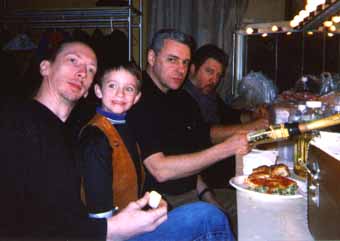
The first stretch of our tour was the mildest as far miles to drive. Since we
had two cars, we had room enough for an extra passenger I decided to take along
my almost six year old son, Jordan, to give him a first hand look at the road
and the experience of creating music for people. Since he was in school at the
time, we turned the trip into a project where he kept a visual journal and as
part of what we would later present to his class, he brought his own camera,
included below are some of his shots. This shot in the dressing room of the
Hampden Theater I took of him with the band during chow time.
March 25-Buttonwood Tree, Middletown, CT.
March 26-U of M, Amherst, MA.
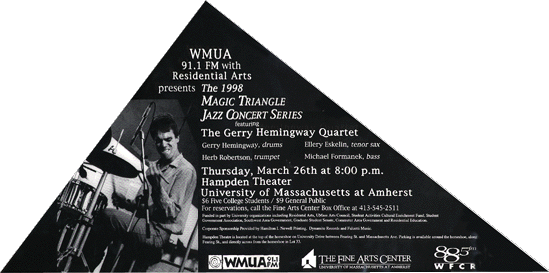
March
27-M.I.T., Boston, MA.
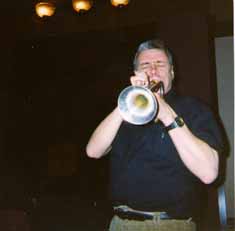 GERRY HEMINGWAY: PIECE WORK (Review-Boston
Phoenix-Jon Garelick) For an established jazz player, Gerry Hemingway operates
on a wavelength that's about as underground as you can get. He made his name
as the drummer with Anthony Braxton's mid-'80s quartet, and his sensitive, tuneful
playing has brought him into orbit with I a slew of other major artists - Ray
Anderson, Marilyn Crispell, George Lewis, Mark Helias, to name a few. But Hemingwav's
own work as a composer and bandleader exists either on import-only releases
or obscure domestic indies. When he brought a quartet into MIT's Killian Hall
last Friday (for a Boston Creative Music Alliance show), he personally sold
a handful of recent titles from a piano bench between sets.
GERRY HEMINGWAY: PIECE WORK (Review-Boston
Phoenix-Jon Garelick) For an established jazz player, Gerry Hemingway operates
on a wavelength that's about as underground as you can get. He made his name
as the drummer with Anthony Braxton's mid-'80s quartet, and his sensitive, tuneful
playing has brought him into orbit with I a slew of other major artists - Ray
Anderson, Marilyn Crispell, George Lewis, Mark Helias, to name a few. But Hemingwav's
own work as a composer and bandleader exists either on import-only releases
or obscure domestic indies. When he brought a quartet into MIT's Killian Hall
last Friday (for a Boston Creative Music Alliance show), he personally sold
a handful of recent titles from a piano bench between sets.
This is a shame.
Hemingway composes rigorous, attractive pieces for small ensemble. At MIT there
was plenty of fancy solo work from his band (trumpeter Herb Robertson, tenor-sax
Ellery Eskelin, bassist Michael Formanek), and lots of typically avant "extended"
techniques, with false registers, vocalizing, and odd musical toys, including
a tube that Hemingway blew into the drum to manipulate the pitch on one of his
drumheads. Yet however far afield an individual player traveled, the piece was
always the thing.
Hemingway likes
standard song forms. He can fashion strutting, angular, boplike lines for unison
horns over walking bass (as he did in the new "Full Off"), replete
with nifty little stop-time breaks. But at MIT he rarely settled for tune- solos
-tune. Hemingway and bassist Michael Formanek, created constantly shifting rhythmic
backdrops. Formanek moved fluidly from walking quarter notes to rapid, high
drones to abstract filigree, and Hemingway's drumming favored a loose pulse,
all the better to acquit his taste for layered tempos. Whenever your mind had
settled into one of Hemingway's pieces, he cued a new melody, a new mood, a
new texture. No matter how slowly his pieces developed, they were always on
their way somewhere.
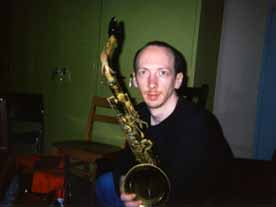 The last tune of the night, "Toombow," was typical.
Formanek introduced it with an abstract bass figure before trumpet and tenor
entered with stuttering fast clusters of notes. Hemingway began laying down
a loose beat with his hands, got some talking-drum effects with his blowtube,
shifted textures from palms to pattering fingertips to lightly scratching fingernails.
He settled into a regular beat, the horns stated a contrapuntal theme, Formanek
moved in and out of a funky bass ostinato, and then the beat became Latinized.
There was a tenor solo, Hemingway's backbeat hardedned and the theme returned,
flying. In 20 minutes, the band had gone from free jazz to hard Latin funk,
and it was all of a piece.
The last tune of the night, "Toombow," was typical.
Formanek introduced it with an abstract bass figure before trumpet and tenor
entered with stuttering fast clusters of notes. Hemingway began laying down
a loose beat with his hands, got some talking-drum effects with his blowtube,
shifted textures from palms to pattering fingertips to lightly scratching fingernails.
He settled into a regular beat, the horns stated a contrapuntal theme, Formanek
moved in and out of a funky bass ostinato, and then the beat became Latinized.
There was a tenor solo, Hemingway's backbeat hardedned and the theme returned,
flying. In 20 minutes, the band had gone from free jazz to hard Latin funk,
and it was all of a piece.
Part
2:April 15-April 27th
Ray
Anderson-trombone, Ellery Eskelin-tenor
Michael Formanek-bass, Gerry Hemingway-drums
The second leg of our tour was in two parts, the first
of which we drove out and back from the Detroit area. The second part took us
to the Southwest by plane. We had some interesting moments getting Mike's bass
trunk strapped atop a van in Tucson as it was the only way to get back and forth
from Phoenix.
April 15-Blairstown, Arts Center, Blair Academy
April 16-Pittsburg, Public Health Auditorium, Fifth & DeSoto Sts.
April 17-Ohio, Bop Stop
April 18-Detroit, Kerrytown Playhouse
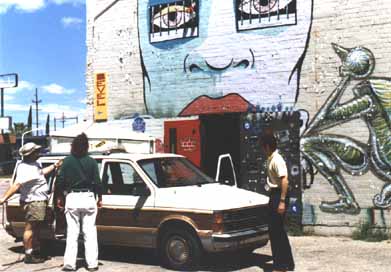
April
23-Tucson, Mat Bevel Institute
April 24-Albuquerque, Outpost
April 25-Albuquerque, Outpost
April 26-Denver, Maximilians (Creative Music Works)
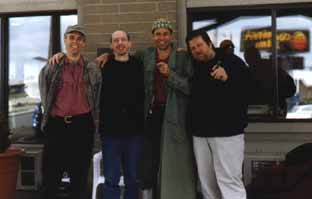
Part 3 :May 13th-May 17th,1998
Ray Anderson-trombone, Ellery Eskelin-tenor
Mark Dresser-bass, Gerry Hemingway-drums
This was to be the longest leg of the tour originally designed as
a giant loop north to Canada, west to Chicago down to New Orleans and east to
the middle of Florida and finally north, back up the east coast towards home.
Unfortunately the gigs in the south around New Orleans didn't come together
the way I hoped they would so I decided reluctantly to cancel our appearances
in Chicago and St. Louis and come home for a few days. With the break between
these two sections we ended up splitting the brass chair between Herb and Ray.
May
13-Buffalo, N.Y., Hallwalls
May 14-travel to Victoriaville
May 15-Victoriaville, PQ, Victo Festival
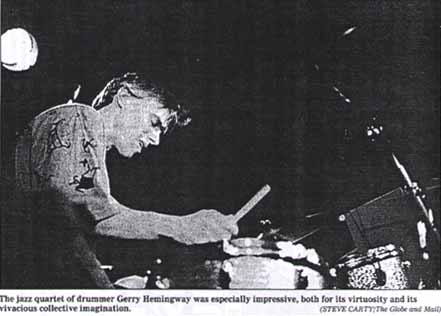
The Globe and
Mail, Tuesday, May 19, 1998-VICTORIAVILLE FESTIVAL LIVES UP TO ITS AMBITIONS
Of
the jazz ensembles in attendance, the Gerry Hemingway Quartet and Doppelmoppel
were especially impressive, both for their virtuosity and their vivacious collective
imagination. Drummer Hemingway and his fellow Americans Ray Anderson (trombone),
Ellery Eskelin (tenor saxophone) and Mark Dresser (bass) played an extended
sort of hard bop on Friday night, abstracting that tradition's salient points
into towering designs that wobbled wildly off centre......
Mark Miller-Special to The Globe and Mail
May 16-Toronto, ON., Rivoli
Herb Robertson-trumpet, Ellery Eskelin-tenor
Mark Dresser-bass, Gerry Hemingway-drums
May 22-Philadelphia, PA.-The Unitarian Church, 22nd & Chestnut Sts 7pm !!
(Sweetnighter Prod., for more info)
May 23-Atlanta, GA.Nexus Cont. Arts Center, 535 Means St.
May 24-Orlando, FL.-Sapphire Supper Club 8:00
Hemingway:
The Fabled Different Drummer/Musician is bringing his adventurous music home
to America
ORLANDO
SENTINEL May 23rd, 1998
"I'm not tired
of Europe" said drummer-composer Gerry Hemingway.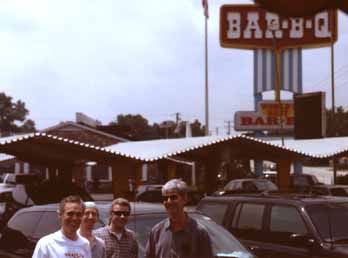
But after years
of leading a predominantly European quintet and recording and touring primarily
in the U.K and elsewhere in Europe,
Hemingway is eager to start making noise back home. To that end,
he unveiled a new U.S.-based quartet last fall and has put together a fairly
extensive tour that brings him to Orlando's Sapphire Supper Club Sunday with
bassist Mark Dresser, tenor saxophonist Ellery Eskelin and trumpeter Herb Robertson.
"Coordinating
all this has been a major amount of work," Hemingway said. "And it's
difficult to get the financial end to line up so everything, is really satisfactory
on the same kind of level as in Europe. It's almost impossible. But it's sort
of an investment on my part, to bring the band across the country and set up
the groundwork so it might be possible to do some recording for a more major
label. Hopefully having the band heard all over the U.S., and having reviews
and previews and interviews all over, will demonstrate to any company that we
are more American oriented and we have a track record here."
Many jazz and avant-garde
musicians resign themselves to the fact that Europe is a more open, educated
and lucrative market. And they adopt the belief that they can find the creative
freedom they need only on independent labels. But Hemingway said he thinks it's
merely a matter of introducing more American listeners to adventurous music,
and to do that with his music, he needs to get a major label to promulgate it.
"It's a game
of manipulation, basically," Hemingway said from Victoriaville, a small
town in Quebec that hosts a large and prestigious avantgarde music festival
every year. "It's learning how to manipulate the company to do what you
want them to do while they think they're manipulating you. They think they're
getting what they want while you're working out how to get more or less what
you want. There's a way to make it work and keep your integrity. I see it as
totally possible.".
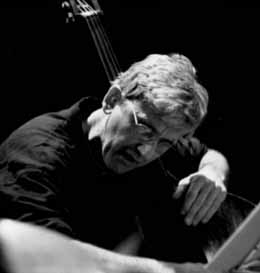 And Hemingway certainly would not feel tainted by association
with a label that is more interested in commerce than art.
And Hemingway certainly would not feel tainted by association
with a label that is more interested in commerce than art.
"I'm not interested
in the purist aesthetic at all," said Hemingway, who speaks in a manner
both professorial and ardent, and at an almost daunting speed, as if the class
bell were about to ring and vital information had yet to be covered. "If
more than two to three times the amount of people show up at concerts than would
normally be there, how much they'll benefit by that! People would love to hear
it if they knew it was there. It's that simple. It's stupid that people just
don't know. It's frustrating that they dont."
Hemingway's music
might sound difficult at first to ears dulled by the likes, of Kenny G and the
Rippingtons. His music is by no means inaccessible, however. He covers a lot
of appealing ground, from the often chamberlike beauty of the quintet (which
comprises Dresser, cellist Ernst Reijseger trombonist Wolter Wierbos and reed
player Michael Moore) to some downright funky and exuberant work with the quartet.
Hemingway's compositions
and improvisations have a strong sense of melody andwhile there is a degree
of abstraction, the music seems more emotional than cerebral. (In other words,
if you can handle Medeski, Martin & Wood, you're ready for this although
you can't dance to all of it.) Anyone who loves great drumming will be taken
with the vigor and variety of his playing and fascinated by the rhythmic complexity
of the pieces. Hemingway said working with Dresser, and in other collaborations
with Mark Helias and Michael Formanek, he has been able to create the kind of
exciting rhythmic foundation he wants in his music
"They've developed
a real understanding and very quick sense of which way we're all going with
stuff," Hemingway said. "For instance, all three guys have a very
good sense of something called rhythmic modulation - when you're riding along
and the tempo changes as if by magic to some other tempo. In fact, the tempos
are related, but it doesn't necessarily strike you when you hear it.
It grows originally
out of [Charles] Mingus' point of view. He liked to have tempo diversity when
he was playing, but it was kind of a be-bop thing where everyone was playing
the same tempo at the same time all the time but would move around, modulate
up and modulate down. Mingus would do that, but he tended to do it in a very
set kind of way. We do it in a more improvised kind of way, which creates a
kind of shifting ground for any improviser to work on and different landscapes
to deal with, different terrains to negotiate when you're playing on top of
that. In addition, Mark and I also work on other levels of similar and different
tempos, different layers of rhythmic momentum going on at once, all at the same
time."
Hemingway began
his explorations at Yale University in New Haven, Conn., in the mid'70s, collaborating
with trombonist George Lewis, pianist Anthony Davis and trumpeter Leo Smith.
He started his own label, Auricle, and put out solo material and albums by his
trio Oahspe (later called BassDrumBone), which includes Helias and trombonist
Ray Anderson. Hemingway, along with Dresser, has also worked frequently with
Anthony Braxton and Marilyn Crispell.
In addition to
recording his own albums for labels such as Hat Art and Sound Aspects, Hemingway
has also recorded and performed with Derek Bailey, Oliver Lake, John Cale, Hank
Roberts, Reggie Workman and others. He has also received commissions for orchestral
and chamber ensemble works, collaborated with video artist/animator Beth Warshafsky
and generally kept himself far too busy to really have time to serve as his
own booking agent, tour manager, Web master and record distributor.
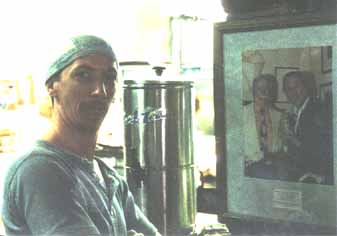 Hemingway's latest album, by the way, is Johnny's Corner
Song, featuring the quartet with trombonist Robin Eubanks i-11 place of Robertson.
It's a sort of limited-edition live album, available only at shows or through
Hemingway's Web site - http://www. interactive. net/-gerryhem. Hemingway hopes
the quartet's next recording will be a studio album, properly backed and promoted
by a label with major resources.
Hemingway's latest album, by the way, is Johnny's Corner
Song, featuring the quartet with trombonist Robin Eubanks i-11 place of Robertson.
It's a sort of limited-edition live album, available only at shows or through
Hemingway's Web site - http://www. interactive. net/-gerryhem. Hemingway hopes
the quartet's next recording will be a studio album, properly backed and promoted
by a label with major resources.
"I could continue
living at this level," he said. "It's fine. I'm not trying to be a
millionaire. I'm just trying to get it [music] out to more people. It would
be just lovely if that could happen. And people do break through. Don Byron
got through. Joe Lovano made his way Others make their way. Tim Berne flipped
on Columbia for a couple outings, and other people I know have done it. It always
takes some sort of twist of fate. And I have my ways. I have my tricks lined
up."
By Parry Gettelman-SENTINEL
POPULAR MUSIC CRITIC
May 25-St. Petersburg, FL.-Salvador Dali Museum
May 26-Columbia, S.C.
May 27-off
May 28-Durham, N.C.-Nelson Music Room, Duke Univ.(for
more info)
Hemingway
means business but he's not corporate
By OWEN CORDLE-CORRESPONDENT
A small businessman
tip against corporate America, drummer Gerry Hemingway does not play franchise
jazz. He travels to Europe a lot, where the cultural vibe is better, to perform
with his quintet comprised of three Netherlands based jazzmen and two Americans.
But in a rare U.S.
tour, he is doing 40 concerts in four months with his American quartet, which
includes trumpeter Herb Robertson, tenor saxophonist Ellery Eskelin and bassist
Mark Dresser (who is also in the European group). The quartet performs Thursday
at Duke University's Nelson Music Room.
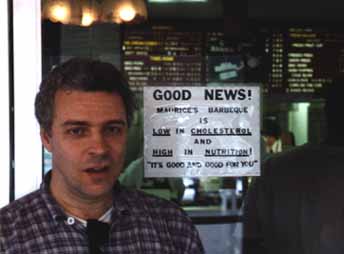 "I'm running around this country losing money
to put a band up I believe in," the 43-year-old drummer said in a call
from his horne in Hackettstown, N.J. "I think there's far more hunger for
this everywhere."
"I'm running around this country losing money
to put a band up I believe in," the 43-year-old drummer said in a call
from his horne in Hackettstown, N.J. "I think there's far more hunger for
this everywhere."
One manifestation
of the hunger for this music (which has been called avant-garde jazz) is the
formation last year of the concert's sponsor, the Alliance for Improvised Music,
a group dedicated to promoting alternative jazz in the Triangle.
In September, AIM
presented Eskelin's trio at the Nelson Music Room. Dresser also has been heard
in the Triangle, at Cappers in 1996, with soprano saxophonist Jane Ira Bloom.
And in 1993 Hemingway appeared with pianist Marilyn Crispell at the ArtsCenter
"In the U.S.
we have the notion that if we're going into music we have to decide what we
can and can't listen to," Hemingway said. "Unfortunately, all of our
culture is entirely based along the notion of comfort. We don't accept things
feel instead of making us fall asleep at the wheel. "Jazz has tremendous
corporate leanings like everything else in world," he said. "I sure
hope jazz as the music of individuals and individualistic thinking can survive
this onslaught of the corporate world to make us all think alike, like we're
all groovy and happy. 'Cause it ain't true."
Hemingway doesn't
buy the traditional argument that all jazz must have a clear lineage to New
Orleans. "My notion of what jazz is is a far more open-minded and flexible
point of view than the coat-and-tie position," he said. "I think it's
an inclusive niusic that's ever voracious in its appetite to include more and
more kinds of elements in its form - and has the possibility and flexibility
to do that."
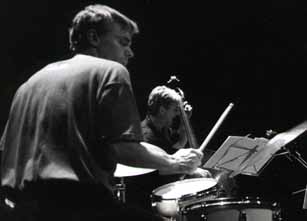 Flexibility is Hemingway's modus operandi with respect
to rhythm. The time doesn't have to be strict, it can fluctuate due to momentum,
forward motion and pulse. He and Dresser have worked out what he calls "multilevel"
time: playing different tempos simultaneously, speeding and slowing time, weaving
around an implied beat, modulating time. "I treat time more like an elastic
band," he said. "But I know where I am all the time. It's just a skill."
Flexibility is Hemingway's modus operandi with respect
to rhythm. The time doesn't have to be strict, it can fluctuate due to momentum,
forward motion and pulse. He and Dresser have worked out what he calls "multilevel"
time: playing different tempos simultaneously, speeding and slowing time, weaving
around an implied beat, modulating time. "I treat time more like an elastic
band," he said. "But I know where I am all the time. It's just a skill."
When he composes,
Hemingway doesn't just proceed from rhythm. In fact, he relates more to harmony.
Hemingway, as a teenager, rejected the concept of rightnote, wrong-note in regard
to harmonic convention. He reasoned that a melodic idea almost always ow!rrules
a harmonic idei, Coleman's innovation is still the historic dividing line between
mainstream and avant-garde jazz. (Hemingway spent a lot of time with the late
Ed Blackwell, the Coleman quartet's drummer, when Blackwell was undergoing dialysis
treatment in the '80s.)
"Avant-garde
is a misunderstood term just like jazz is a misunderstood term," Hemingway
said. "If it's avantgarde, then how does that explain the presence of all
of this hardswinging blues-oriented stuff? But if it's supposed to be that,
how does that explain the presence of all of this sound orientation where you
can't tell what instrument is playing what? So we're stuck there, we're inbetween
the lines as usual." Hemingway is best known for his 12-year tenure with
alto saxophonist and composer Anthony Braxton's quartet. Even longer is the
twenty-one year old association, BassDrumBone, with Hemingway, bassist Mark
Helias and trombonist Ray Anderson. He has also worked with trumpeter Leo Smith
(another AIM-sponsored jazzman heard in the Triangle recently), bassist Reggie
Workman and pianist and composer Anthony Davis, among many others. Hemingway
also performs solo concerts, sometimes mixing electronics with his percussion.
The albums "The Marmalade King" (hat Art) and "Slamadam"
(Random Acoustics), both by his European quintet, received rave reviews in Down
Beat in late 1995. The current quartet is "generally pretty accessible,"
Hemingway said. "People are moved by it, if for nothing else than by its
honesty, its directness and its visceral I quality. I mean, the group gets down.
You wont go out of there not feeling something. We mean business. And it's got
a lot of beauty in it too. Owen Cordle
May 29-Washington, D.C., Phillips Hall Rm B120, George Washington University,
801 22nd St NW
June
10th-June 21st 1998
Ray Anderson-trombone, Ellery Eskelin-tenor
Mark Dresser-bass, Gerry Hemingway-drums
The final leg
of the tour covered alot of ground starting with an appearance at Burlington's
Discover Jazz festival, my brother Sam's home town. Sam is a journalist for
the Burlington Free Press. His preview of the concert had some very early historical
references as you might imagine. I'll post his article soon as he gets me the
promised copy. From the Northeast we made our way out to the West Coast and
covered territory from San Diego all the way up to Vancouver. Our stop in LA
with a performance at Luna Park in the Hollywood section was jammed pack and
particularly crazy, replete with a casting agent coming up and trying to get
our resumes as we packed up frantically to make room for the second act. The
tour ended with appearance at three of the Westcan festivals. I hear the tape
of the Vancouver concert is quite good (I am still awaiting a copy).....who
knows?
June 10-Burlington, VT., Contois Hall, Discover Jazz Festival
(for more info)
June 11-workshop
June 12-Hartford, CT., Real Arts Ways
June 13-Ventura, CA., Ventura City Hall, 501 Poli
June 14-San Diego, CA., Spruce St. Forum (for
more info)
Preview-Gerry
Hemingway Quartet-Spruce Street Forum & Gallery- Mark Lewls, Sidewalk
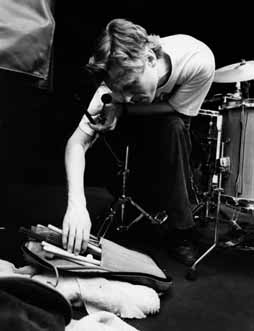 Touring with only a basic
kit, Hemingway's into layering different pulses. (PHOTO)
Touring with only a basic
kit, Hemingway's into layering different pulses. (PHOTO)
The life of oddity
is inspiring, and we should all live for it. We should all make up our own words
(and get our friends to use them) and invent our own systems of writing; make
weird noises in our kitchens and our bathrooms; write encyclopedias, play instruments
well and badly. We should all prowl waterfronts where there are labyrinthine
docks, outbuildings, walls and terraces; read and write graff iti while the
medieval groundskeeper comes out howling that we should vacate the premises
immediately. Everyone should try drawing with a pen or pencil (no two people
make identical marks; it's more unique than handwriting or fingerprints).
We should all lie
prostrate in the cities of the world, let them die around us, then take a deep
breath and get up again. We should all enter our place of employ nude, at least
once, not in the name of the principle of trying everything (dangerous and harmful
for some activities), but to recall that a civilization that can control temperature
indoors doesn't need clothing. We should all engage the government in lengthy
correspondence about obscure public works problems that they have to investigate
to see if they're real; we should all have our own garage radio stations, or
at least have a special hotline telephone where you can call a person from any
country in the world for free and talk to him or her (and get a translator to
join the conversation if you can't speak the other person's language). We should
all try to invent something, not to try to make a bundle off it, but to prove
that absurd beginnings can end up wrecking the most cherished paradigms. We
should all find a complete stranger in a room in our house, someone who's a
raving eccentric nut and refuses to leave, but isn't violent and doesn't cause
trouble; we should try babbling at important court hearings, meetings with doctors
and when announcing proposals for our latest grand idea.
We should all listen
to drummer Gerry Hemingway's Quartet, or at least other musicians who challenge
the world's mundane plasticity with this outfit's super-elastic slugging swing.
The members of this New York group (tenor Ellery Eskelin, bassist Mark Dresser
and trombonist Ray Anderson) are at their creative peak - hear them now, so
that you don't have to hear stories about it from some old geezer in a nursing
home, telling you how he remembers when Coltrane wailed so long that the rest
of the band just left the stage and let him keep searching on his own.
Hemingway's music,
not to mention every member of the band (they all have significant projects
individually) defies taking a back seat on the jazz bus, or even riding as a
passenger; but that's not such a big deal anymore: the currents of creative
music are accelerating in so many directions at present that it's a simplification
to say everyone has the same ideas about improvisation, texture and use of original
material. ("I think it's a great time," says Eskelin, "because
10 musicians can have 10 different concepts about music and they can all exist
together.") Playing material culled from Hemingway's European quintet,
this crew has a hunger for the new, a playfulness that's built on the expanded
potential of their instruments (doing more with less), and an awareness of developments
in other musical genres, even in other art forms.
But if you're going
to peer within and look for the roots and the tombs, look to the collective
ingenuity of a'20s New Orleans band, the teachings of the Association for the
Advancement of Creative Musicians, the sweatlodge of the70s New York loft scene.
Hang your head over the Chicago gutbuckets, the smell of fresh Zappa roasting
on the open spit of a Sun Ra fire; tread heavily and thoroughly, with clogs,
on Anthony Braxton's doorstep; hide your talismanic fingernails inside the skins
of West African, South Indian and Western European percussion (that's your siren,
Edgard Var6se). Place your bets on the Third Stream constructionists, the Lydian
Chromatic Concept (earned in sweat-pennies when George Russell wiped down lunch-counters),
and the song-poems of Rodd K-eith. (who Eskelin recently discovered was his
father).
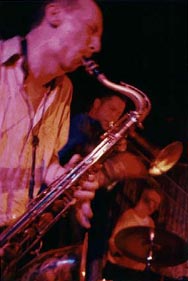 June 15-L.A., Luna Park, New Music
Monday, (for more info)
June 15-L.A., Luna Park, New Music
Monday, (for more info)
June 16-Oakland, Beanbenders (for
more info)
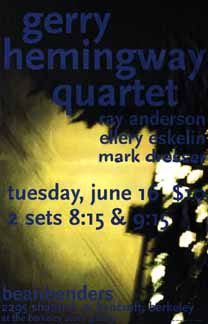
June 17-off
June 18-Seattle, WA., Earshot Jazz
June 19-Saskatoon, Saskatchewan, The Bassment (festival, for
more info)
June 20-Vancouver, BC. (festival)
June 21-Edmunton, Alberta (festival)
HEMINGWAY'S
QUARTET FIND THEIR OWN BRILLIANT MUSICAL CONVERSATION
The mood downstairs
with drummer Gerry Hemingway's Quartet and 150 spellbound listeners in the cozier
Marlboro Room was a stark contrast (from Lenny Pickett & Tower of Power),
but at least as lethal in its own challenging way. It's always a paradox to
catch small group work that feels lazy and precision controlled at the same
time but that was part of the effect when the drummer, bassist Mark Dresser,
trombonist Ray Anderson and saxophonist Ellery Eskelin played four "tunes"
into an hour-plus opening set- that usually started with what felt like collective
improvisation.
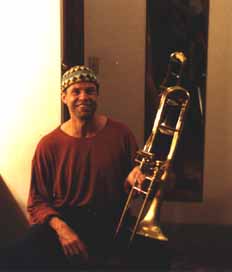 The musical chemistry was an additive process, starting from
scratch, gradually dropping in subtle ingredients of texture and making unexpected
connections, taking lazy turnabouts and sonic fishtails that seemed to fall
into a groove almost by accident. It was about examining tonality and making
sirens out of sudden wailing thoughts, and most of all, about connecting in
brash and , witty conversations that could almost make a listener wince at the
edginess if you weren't so happily entranced.
The musical chemistry was an additive process, starting from
scratch, gradually dropping in subtle ingredients of texture and making unexpected
connections, taking lazy turnabouts and sonic fishtails that seemed to fall
into a groove almost by accident. It was about examining tonality and making
sirens out of sudden wailing thoughts, and most of all, about connecting in
brash and , witty conversations that could almost make a listener wince at the
edginess if you weren't so happily entranced.
Hemingway himself
can shift through endless permutations of pulse, loose but so tight, until he's
practically throttling his set in a loving way. And Anderson's inventions reminded
us that the trombone has no limits in the right hands. On Slamadam all four
showed themselves to be masters of their art using techniques that bridge the
straight and narrow with unorthodox approaches and logical noise, building to
a hair-raising intensity and making it all seem quite usual. Mario Pietramala,
The Edmunton Journal, Monday June 22nd, 1998
Back
to Quartet Page


 GERRY HEMINGWAY: PIECE WORK (Review-Boston
Phoenix-Jon Garelick) For an established jazz player, Gerry Hemingway operates
on a wavelength that's about as underground as you can get. He made his name
as the drummer with Anthony Braxton's mid-'80s quartet, and his sensitive, tuneful
playing has brought him into orbit with I a slew of other major artists - Ray
Anderson, Marilyn Crispell, George Lewis, Mark Helias, to name a few. But Hemingwav's
own work as a composer and bandleader exists either on import-only releases
or obscure domestic indies. When he brought a quartet into MIT's Killian Hall
last Friday (for a Boston Creative Music Alliance show), he personally sold
a handful of recent titles from a piano bench between sets.
GERRY HEMINGWAY: PIECE WORK (Review-Boston
Phoenix-Jon Garelick) For an established jazz player, Gerry Hemingway operates
on a wavelength that's about as underground as you can get. He made his name
as the drummer with Anthony Braxton's mid-'80s quartet, and his sensitive, tuneful
playing has brought him into orbit with I a slew of other major artists - Ray
Anderson, Marilyn Crispell, George Lewis, Mark Helias, to name a few. But Hemingwav's
own work as a composer and bandleader exists either on import-only releases
or obscure domestic indies. When he brought a quartet into MIT's Killian Hall
last Friday (for a Boston Creative Music Alliance show), he personally sold
a handful of recent titles from a piano bench between sets. The last tune of the night, "Toombow," was typical.
Formanek introduced it with an abstract bass figure before trumpet and tenor
entered with stuttering fast clusters of notes. Hemingway began laying down
a loose beat with his hands, got some talking-drum effects with his blowtube,
shifted textures from palms to pattering fingertips to lightly scratching fingernails.
He settled into a regular beat, the horns stated a contrapuntal theme, Formanek
moved in and out of a funky bass ostinato, and then the beat became Latinized.
There was a tenor solo, Hemingway's backbeat hardedned and the theme returned,
flying. In 20 minutes, the band had gone from free jazz to hard Latin funk,
and it was all of a piece.
The last tune of the night, "Toombow," was typical.
Formanek introduced it with an abstract bass figure before trumpet and tenor
entered with stuttering fast clusters of notes. Hemingway began laying down
a loose beat with his hands, got some talking-drum effects with his blowtube,
shifted textures from palms to pattering fingertips to lightly scratching fingernails.
He settled into a regular beat, the horns stated a contrapuntal theme, Formanek
moved in and out of a funky bass ostinato, and then the beat became Latinized.
There was a tenor solo, Hemingway's backbeat hardedned and the theme returned,
flying. In 20 minutes, the band had gone from free jazz to hard Latin funk,
and it was all of a piece.



 And Hemingway certainly would not feel tainted by association
with a label that is more interested in commerce than art.
And Hemingway certainly would not feel tainted by association
with a label that is more interested in commerce than art. Hemingway's latest album, by the way, is Johnny's Corner
Song, featuring the quartet with trombonist Robin Eubanks i-11 place of Robertson.
It's a sort of limited-edition live album, available only at shows or through
Hemingway's Web site - http://www. interactive. net/-gerryhem. Hemingway hopes
the quartet's next recording will be a studio album, properly backed and promoted
by a label with major resources.
Hemingway's latest album, by the way, is Johnny's Corner
Song, featuring the quartet with trombonist Robin Eubanks i-11 place of Robertson.
It's a sort of limited-edition live album, available only at shows or through
Hemingway's Web site - http://www. interactive. net/-gerryhem. Hemingway hopes
the quartet's next recording will be a studio album, properly backed and promoted
by a label with major resources. "I'm running around this country losing money
to put a band up I believe in," the 43-year-old drummer said in a call
from his horne in Hackettstown, N.J. "I think there's far more hunger for
this everywhere."
"I'm running around this country losing money
to put a band up I believe in," the 43-year-old drummer said in a call
from his horne in Hackettstown, N.J. "I think there's far more hunger for
this everywhere." Flexibility is Hemingway's modus operandi with respect
to rhythm. The time doesn't have to be strict, it can fluctuate due to momentum,
forward motion and pulse. He and Dresser have worked out what he calls "multilevel"
time: playing different tempos simultaneously, speeding and slowing time, weaving
around an implied beat, modulating time. "I treat time more like an elastic
band," he said. "But I know where I am all the time. It's just a skill."
Flexibility is Hemingway's modus operandi with respect
to rhythm. The time doesn't have to be strict, it can fluctuate due to momentum,
forward motion and pulse. He and Dresser have worked out what he calls "multilevel"
time: playing different tempos simultaneously, speeding and slowing time, weaving
around an implied beat, modulating time. "I treat time more like an elastic
band," he said. "But I know where I am all the time. It's just a skill." Touring with only a basic
kit, Hemingway's into layering different pulses. (PHOTO)
Touring with only a basic
kit, Hemingway's into layering different pulses. (PHOTO) June 15-L.A., Luna Park, New Music
Monday, (
June 15-L.A., Luna Park, New Music
Monday, (
 The musical chemistry was an additive process, starting from
scratch, gradually dropping in subtle ingredients of texture and making unexpected
connections, taking lazy turnabouts and sonic fishtails that seemed to fall
into a groove almost by accident. It was about examining tonality and making
sirens out of sudden wailing thoughts, and most of all, about connecting in
brash and , witty conversations that could almost make a listener wince at the
edginess if you weren't so happily entranced.
The musical chemistry was an additive process, starting from
scratch, gradually dropping in subtle ingredients of texture and making unexpected
connections, taking lazy turnabouts and sonic fishtails that seemed to fall
into a groove almost by accident. It was about examining tonality and making
sirens out of sudden wailing thoughts, and most of all, about connecting in
brash and , witty conversations that could almost make a listener wince at the
edginess if you weren't so happily entranced.